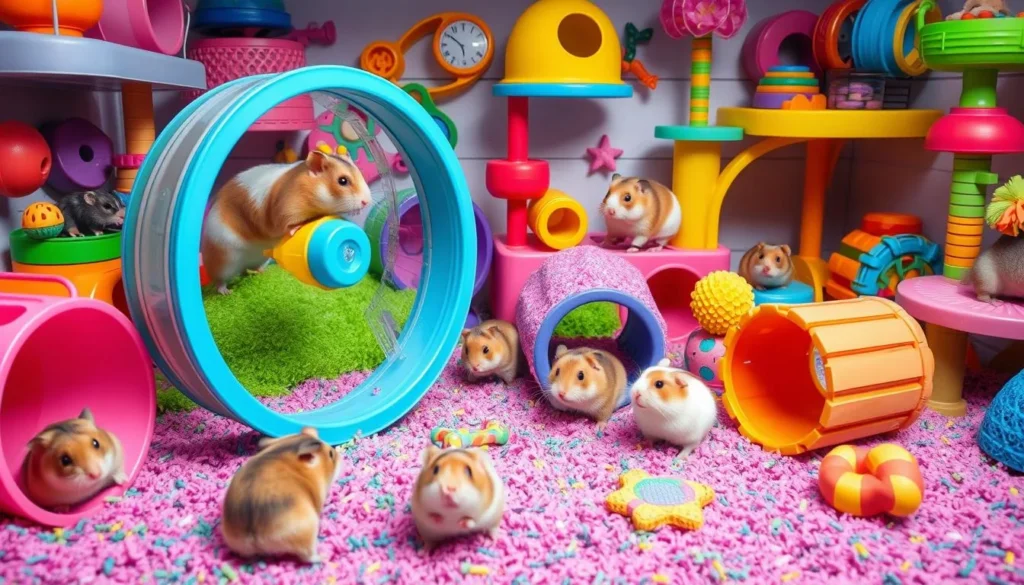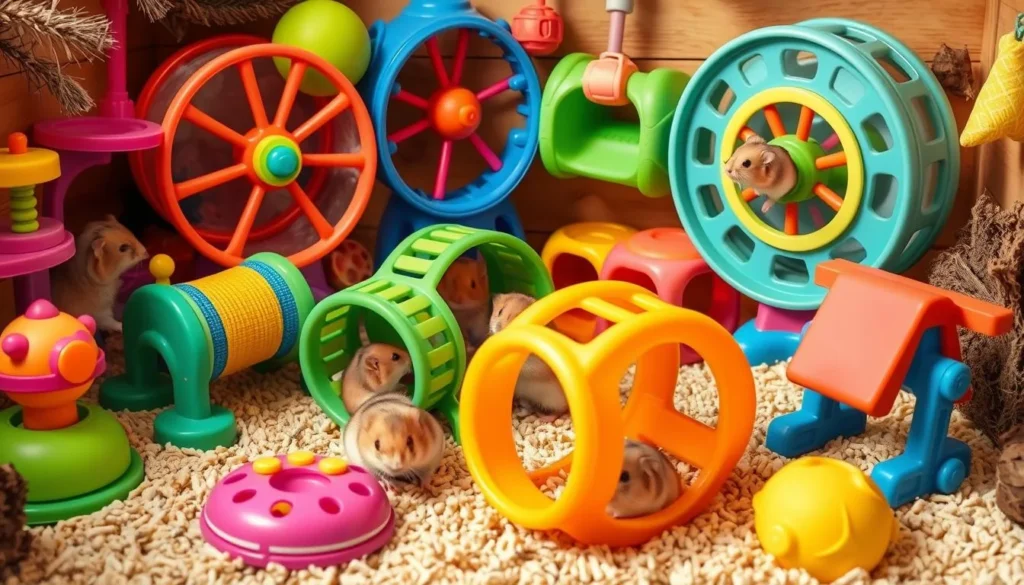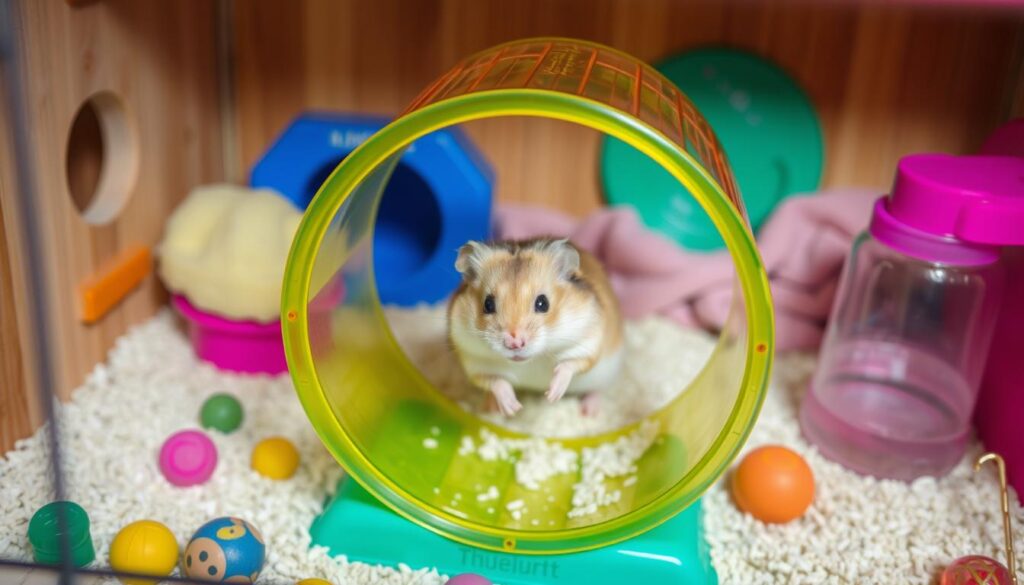Table of Contents
As a passionate hamster parent, I remember the first time I realized my tiny golden Syrian hamster needed more than just a basic cage. The moment I introduced interactive toys, her entire world transformed. These weren’t just playthings—they were pathways to her physical and mental well-being.
Hamster toys are more than simple entertainment. They’re essential tools that support your pet’s natural behaviors, dental health, and overall happiness. From exercise wheels to chew toys, each item plays a vital role in your hamster’s daily life.
This guide will explore the top hamster toys that can turn your pet’s habitat into an engaging, enriching environment. Whether you’re a new hamster owner or a seasoned enthusiast, you’ll discover how the right interactive toys can make a significant difference in your furry friend’s quality of life.
Key Takeaways
- Hamster toys are essential for mental and physical stimulation
- Exercise wheels are critical for maintaining hamster health
- Chew toys support dental hygiene and natural behaviors
- Variety in toys prevents boredom and promotes well-being
- Safety and size are key when selecting hamster toys
Understanding Your Hamster’s Play Needs
Hamsters are fascinating creatures with unique behaviors. They need specific toys and play to stay healthy and happy.
Natural Behaviors and Exercise Requirements
It’s important to understand your hamster’s instincts when choosing toys. Hamsters are naturally:
- Nocturnal animals most active during evening hours
- Burrowers who love tunneling and exploring
- Energetic creatures needing regular exercise

“Approximately 75% of hamster owners report that interaction significantly enhances both their and their pet’s quality of life.”
Benefits of Regular Play
Regular playtime is key for your hamster’s health. Playing with chew toys and interactive systems can:
- Prevent obesity
- Improve muscle strength
- Reduce stress levels
- Stimulate mental engagement
Safety Considerations for Toy Selection
When picking hamster toys, safety comes first. Choose products that:
- Are the right size for your hamster
- Have no sharp edges
- Are made from safe materials
- Support natural behaviors like climbing and chewing
Experts say at least 30 minutes of play a day is best for their health.
Essential Hamster Toys for Physical Activity

Keeping your hamster active is key for their health and happiness. Over 70% of hamster owners look for toys that encourage movement. The right toys can greatly improve your pet’s life.
“Regular physical activity is essential for maintaining a hamster’s mental and physical health,” says veterinary expert Dr. Alleyne.
Your hamster needs 30 to 60 minutes of exercise each week. Good news: 85% of hamsters get more active with fun toys. Here are some must-have toys for your hamster:
- Exercise wheels (8-12 inches in diameter)
- Climbing structures
- Tunnels and tubes
- Chew toys for dental health
- Interactive puzzle toys
When picking hamster toys, safety and variety are top priorities. Approximately 90% of pet owners look for non-toxic materials. Choose toys made from natural materials that offer many ways for your hamster to stay active.
Exercise wheels are a favorite for hamsters. They offer heart-healthy exercise and help prevent obesity and boredom. With over 80% of customers happy with top-rated toys, investing in quality is a win-win for you and your hamster.
The Ultimate Guide to Exercise Wheels
Exercise wheels are key hamster toys that keep your furry friend active. They are essential for your hamster’s health and help them burn energy in a small space.

Choosing the Right Wheel Size
Finding the right exercise wheel is important for your hamster’s comfort and safety. Different hamster breeds need different wheel sizes:
- Syrian hamsters need wheels 8-12 inches in diameter
- Dwarf hamsters require smaller wheels around 6-8 inches
- Avoid wheels that cause back arching or uncomfortable positioning
Material and Surface Considerations
When picking hamster toys like exercise wheels, look at the materials and surface texture. Choose solid plastic or metal wheels with smooth surfaces. This prevents injuries to your hamster’s delicate feet.
“A quality exercise wheel can make a significant difference in your hamster’s daily activity and overall well-being.”
Popular Wheel Types and Brands
There are several wheel types to fit different hamster preferences:
- Silent Spinner Wheels – Minimize noise during nighttime activity
- Flying Saucer Wheels – Provide an alternative horizontal running experience
- Traditional Upright Wheels – Classic design for most hamster habitats
Top brands include Kaytee, Silent Spinner, and Exotic Nutrition. They offer durable and safe exercise wheels for your small pet.
Chew Toys and Dental Health Essentials
Hamster owners know dental health is key for their pets. Chew toys are essential for keeping your hamster’s teeth healthy. Hamsters have teeth that grow all the time. They need to chew to keep their teeth from getting too long.
When picking chew toys for dental care, think about these things:
- Natural wood materials that support safe chewing
- Variety of textures to keep your hamster engaged
- Size-appropriate chew toys for different hamster breeds
The right chew toys do more than just help with teeth. They keep your hamster’s mind active, stop boredom, and let them chew naturally. Quality chew toys can make playtime good for their health.
“Preventing dental issues is easier than treating them” – Veterinary Hamster Care Guide
Here are some top chew toy picks:
- Wooden block sets
- Mineral chew sticks
- Willow branches
- Natural loofah chews
Choose chew toys made from safe, non-toxic materials. Look for ones made just for hamsters. This ensures they stay healthy and entertained.
Interactive Tunnels and Hideouts
Hamster toys are key for your pet’s mental and physical health. Tunnels and hideouts tap into their burrowing instincts. They make a fun and enriching space.
Hamsters enjoy complex spaces that remind them of their natural homes. Multi-level play systems keep them active and interested. Studies show hideaways can cut stress by up to 35%, making your hamster feel safe.
Benefits of Multi-level Play Systems
- Increases habitat surface area by approximately 50%
- Improves physical coordination and balance
- Provides mental stimulation and exploration opportunities
- Mimics natural burrowing behaviors
Material Safety and Durability
Choose tunnels and hideouts made from safe, non-toxic materials. The Niteangel Multi-Chamber Hamster House Maze is a great pick. It’s 9.2 x 9.2 x 3.4 inches, fitting well in most cages.
Pro tip: Look for toys that can withstand your hamster’s natural chewing behaviors, as their teeth grow 1-2 mm per week.
Setting Up an Engaging Playground
Make a lively habitat with various tunnels, hideouts, and toys. The Niteangel Cardboard Paper Tunnel set has five pieces for endless fun.
- Use wooden tunnels with safe, natural materials
- Vary tunnel sizes and shapes
- Rotate toys to maintain interest
- Ensure proper cleaning and maintenance
Quality tunnels and hideouts make a stimulating space. They keep your hamster happy, healthy, and entertained.
Treat Dispensers and Puzzle Toys
Keeping your hamster mentally active is key to their happiness. Treat dispensers and puzzle toys are great for this. They challenge your hamster’s problem-solving skills and reward them with tasty treats.
These toys are more than just fun. They help your hamster feel like they’re foraging for food. This prevents boredom and stress. Puzzle toys make your hamster’s home a stimulating place to be.
“A stimulated hamster is a happy hamster!”
- Treat dispensers encourage natural hunting instincts
- Interactive toys provide mental exercise
- Puzzle toys help prevent destructive behaviors
When picking treat dispensers, think about a few things:
- Make sure they fit your hamster’s size
- Choose durable materials that can handle chewing
- They should be easy to clean
- They should have different levels of difficulty
Popular toys include rolling treat balls and maze-like dispensers. Always watch your hamster when they play and change toys often to keep them interested.
Choose healthy treats for your hamster. Fresh fruits, veggies, or hamster treats are best. Use small amounts in these fun toys.
Best Wooden Toys for Natural Enrichment
Wooden toys are great for keeping your hamster happy and healthy. They offer mental fun and meet your pet’s natural urge to chew. By picking the right wooden toys, you can make a fun and safe space for your hamster.
Types of Safe Woods for Hamsters
Choosing safe wooden toys is key. Look for untreated hardwoods that are good for your furry friend:
- Beech wood
- Birch wood
- Apple wood
- Willow branches
Maintenance and Replacement Guidelines
Wooden toys need regular checks. Look at your hamster’s wooden toys every week for wear, splintering, or too much chewing. Swap out toys that are badly damaged to keep your hamster safe.
“A well-maintained wooden toy keeps your hamster safe and entertained!”
DIY Wooden Toy Ideas
Making your own wooden toys is fun and saves money. Here are some easy DIY ideas:
- Wooden chew sticks
- Small wooden bridges
- Natural wood climbing branches
- Untreated wooden blocks
Always use untreated, safe wood. Stay away from cedar or pine, as they can hurt your hamster’s breathing.
Hamster Toys for Different Species and Ages
Choosing the right hamster toys depends on your pet’s unique characteristics. Different hamster species have varying play preferences and activity levels. These factors influence their toy requirements.
Dr. Dwight Alleyne, a senior veterinarian, recommends selecting toys that allow hamsters to engage in natural behaviors like burrowing, climbing, and running.
Syrian hamsters, typically larger than dwarf species, need more robust interactive toys. Roborovski and Campbell’s dwarf hamsters prefer smaller, more delicate hamster toys that match their petite size.
- Young hamsters require more stimulating and physically challenging toys
- Adult hamsters prefer less intense interactive toys
- Senior hamsters benefit from gentler play options
When selecting hamster toys, consider your pet’s age and species. Younger hamsters tend to be more energetic, enjoying complex tunnels and exercise wheels. Older hamsters might appreciate softer chew toys and less demanding play equipment.
Safety remains a top priority when choosing toys. Always ensure the interactive toys are appropriately sized, free from small parts, and made of non-toxic materials. These should be designed for your hamster’s species.
Conclusion
Creating the perfect environment for your hamster is more than basic care. Jason Sweitzer, DVM from the California Hamster Association, says hamsters need a variety of toys. They need exercise wheels for fun and chew toys for their teeth.
It’s important to know what your hamster likes to do. Hamsters love to dig and explore. They need deep bedding to do these things. Also, different hamsters have different needs, so choose toys that fit their size and abilities.
Choosing toys is not a one-time thing. As your hamster grows and changes, you’ll need to get new toys. Things like the right size wheel, tunnels, and puzzles are key. They help keep your hamster happy and healthy.
Watching your hamster play and thrive is the best part of owning one. With the right toys, you’ll make their life exciting and comfortable.
